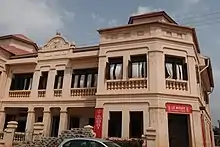Marie-Cécile Zinsou
Marie-Cécile Zinsou (born 1982) is a French-Beninese art historian and entrepreneur, She is president of the Fondation Zinsou, founded in 2005 in Cotonou, Republic of Benin, West Africa,[1] which promotes contemporary art in Africa and leads cultural, educational and social initiatives.[2] In 2014 she opened the first museum of contemporary art in Benin.[3]
Biography

Marie-Cécile Zinsou was born in Paris in 1982 and grew up in France and England.[4][5] She comes from a family of Beninese politicians and intellectuals and has dual French and Beninese nationality. Her father is Lionel Zinsou, an economist, who after years working in France returned to Benin, where he became Prime Minister from June 2015 to April 2016, being beaten in the second round as presidential candidate in the 2016 election. She is also the grand-niece of Émile Derlin Zinsou, former president of Dahomey (now Benin), and of the prominent Beninese cardinal Bernardin Gantin. She studied partly at L'Ecole Alsacienne in Paris, and did further studies in the history of art at the American University of Paris.[1][6][4]
In 2003, she worked at SOS Children's Villages in Abomey-Calavi, Benin, an Austrian non-governmental organization.[1] In 2005, she launched CSEB, a business services company in Benin,[4] and in June that same year with funding from her family was involved with setting up and running the Fondation Zinsou, based in Cotonou[7][8] as an art centre with on-site or travelling exhibitions, publishing books, and also providing libraries and training.[6] In 2013, she opened the Museum of Contemporary Art in Ouidah, the first museum of contemporary art in Benin.[3][9][10] She has said: "The Fondation Zinsou was created to make a space for dialogue between artists and the public. I was working with children and I wanted them to find out about their culture and try to give them an idea of the time we’re living in. Of course, art is the best way to do that. In the end, we thought we couldn’t just focus on contemporary art and so have been working on heritage projects and the heritage building that hosts the museum."[11] She was one of the first people to be featured on IRAWO, a social media platform created by Beninese entrepreneur Mylène Flicka to inspire the next generation of West African young people.[12]
Awards
In 2014 the Fondation Zinsou was awarded a young artists grant from the Japan Art Association's Praemium Imperiale.[13] Also in 2014 she was made a Chevalier de l'ordre des Arts et des Lettres.[4]
References
- Pierre Cochez, "Marie-Cécile Zinsou, une jeune mécène en Afrique", La Croix, 1 October 2010 (in French).
- "Marie-Cécile Zinsou", World Policy Conference.
- "Marie-Cécile Zinsou: she opened the first museum of contemporary art in Benin!", Africa Top Success, 13 February 2014.
- "Marie-Cécile Zinsou", at Leaders-Afrique.com (in French).
- Frédéric Schneider, "Bénin : 'L’accès à la culture' est une priorité, selon Marie-Cécile Zinsou", Afrik.com, 5 October 2015 (in French).
- Nicolas Michel, "Collectionneurs – Bénin: Lionel Zinsou, jamais sans mes filles", Jeune Afrique, 9 November 2012 (in French).
- HenriRobert, "Marie-Cécile Zinsou: Celebrating art in Africa", Happening Magazine, 6 June 2015.
- Magali Lesauvage, "Voyages en Afrique de l'Art", Libération, 29 January 2017 (in French).
- Philippe Dagen, "Benin blazes a trail for African modern art with opening of museum in Ouidah", The Guardian, 6 January 2014.
- Diane-Audrey Ngako, "Marie-Cécile Zinsou: Pourquoi ouvrir une fondation culturelle dans un pays pauvre?", Le Monde, 29 January 2015 (in French).
- "Marie-Cécile Zinsou: founder of the first contemporary art museum in Africa", TrueAfrica, 15 October 2015.
- "Irawo Talents : Mylène Flicka porte la voix des jeunes étoiles africaines – Jeune Afrique". JeuneAfrique.com (in French). 2018-11-21. Retrieved 2020-02-26.
- Léa Desrayaud, "Art: l'encouragement du Praemium Imperiale à la Fondation Zinsou basée à Cotonou", Le Point, 18 July 2014 (in French).
Further reading
- Pierre Cochez, "Marie-Cécile Zinsou, une jeune mécène en Afrique", La Croix, 1 October 2010 (in French).
- Nicolas Michel, "Collectionneurs – Bénin: Lionel Zinsou, jamais sans mes filles", Jeune Afrique, 9 November 2012 (in French).
- "Marie-Cécile Zinsou: elle ouvre le premier musée d’art contemporain au Bénin!", Africa Top Success, 15 November 2013 (in French).
- Diane-Audrey Ngako, "Marie-Cécile Zinsou: Pourquoi ouvrir une fondation culturelle dans un pays pauvre?", Le Monde, 29 January 2015 (in French).
- Léa Desrayaud, "Art: l'encouragement du Praemium Imperiale à la Fondation Zinsou basée à Cotonou", Le Point, 18 July 2014 (in French).
- "Marie-Cecile Zinsou, the new face of African cultural patronage", Inspire Afrika, 10 August 2015.
External links
- "Marie-Cécile Zinsou", at Leaders-Afrique.com (in French).